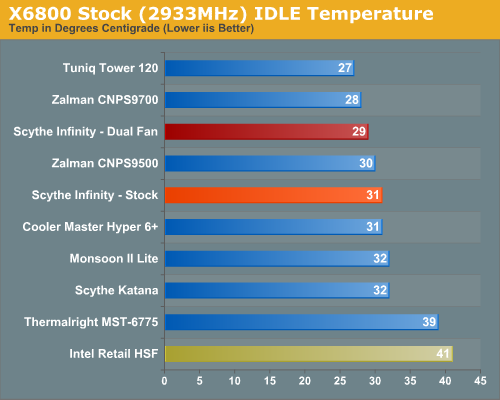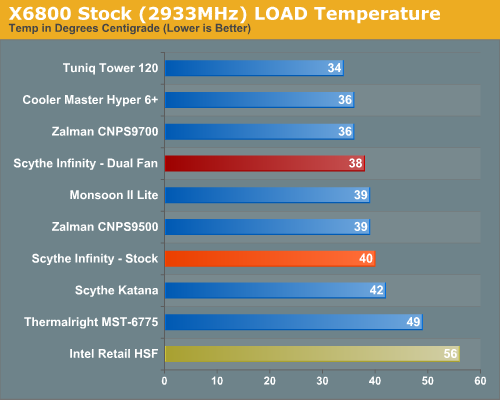Scythe Infinity: 5 Heatpipes and Silent 120mm Fan
by Wesley Fink on February 26, 2007 12:05 AM EST- Posted in
- Cases/Cooling/PSUs
Cooling at Stock Speed
Some users will never overclock their CPU, but they still want to run the coolest CPU temperatures possible to enhance stability and extend CPU life. In this review two new graphs have been added to the test results, so that readers can better compare idle and load performance of the tested coolers at stock X6800 speed of 2.93GHz.

The Scythe Infinity is an excellent performer in CPU cooling at stock speeds. However, when a second cooling fan is added in a push-pull arrangement the cooling gets even better. Stock IDLE cooling is average among the tested coolers with the stock one fan, but a second fan moves the Infinity up as a top performer.
Where the very good Intel stock cooler keeps the X6800 at 41C at idle, the Infinity can manage an excellent 31C/29C, with the stock/dual fans. The push-pull fan setup lands the Infinity in the same ball park with the 27C of the Tuniq Tower and the 28C of the Zalman 9700. These three coolers are the only ones to cool below 30C in our IDLE tests.
It is more difficult to effectively simulate a computer being stressed by all of the conditions it might be exposed to in different operating environments. For most home users CPU power is most taxed with contemporary gaming. Therefore our stress test simulates running a demanding contemporary game.
The Far Cry River demo is looped for 30 minutes and the CPU temperature is captured at 4 second intervals with the NVIDIA monitor "logging" option. The highest temperature during the stress test is then reported. Momentary spikes are ignored, as we report a sustained high-level temp that you would expect to find in this recording configuration.

The stock Infinity was below average under load testing at stock speeds, managing 40C under load compared to the Tuniq 34C and the Cooler Master Hyper 6+ and Zalman 9700 at 36C. Adding the second fan again dropped temperature and improved cooling to 38C for the Infinity dual, which was a better performance.
Some users will never overclock their CPU, but they still want to run the coolest CPU temperatures possible to enhance stability and extend CPU life. In this review two new graphs have been added to the test results, so that readers can better compare idle and load performance of the tested coolers at stock X6800 speed of 2.93GHz.

The Scythe Infinity is an excellent performer in CPU cooling at stock speeds. However, when a second cooling fan is added in a push-pull arrangement the cooling gets even better. Stock IDLE cooling is average among the tested coolers with the stock one fan, but a second fan moves the Infinity up as a top performer.
Where the very good Intel stock cooler keeps the X6800 at 41C at idle, the Infinity can manage an excellent 31C/29C, with the stock/dual fans. The push-pull fan setup lands the Infinity in the same ball park with the 27C of the Tuniq Tower and the 28C of the Zalman 9700. These three coolers are the only ones to cool below 30C in our IDLE tests.
It is more difficult to effectively simulate a computer being stressed by all of the conditions it might be exposed to in different operating environments. For most home users CPU power is most taxed with contemporary gaming. Therefore our stress test simulates running a demanding contemporary game.
The Far Cry River demo is looped for 30 minutes and the CPU temperature is captured at 4 second intervals with the NVIDIA monitor "logging" option. The highest temperature during the stress test is then reported. Momentary spikes are ignored, as we report a sustained high-level temp that you would expect to find in this recording configuration.

The stock Infinity was below average under load testing at stock speeds, managing 40C under load compared to the Tuniq 34C and the Cooler Master Hyper 6+ and Zalman 9700 at 36C. Adding the second fan again dropped temperature and improved cooling to 38C for the Infinity dual, which was a better performance.










39 Comments
View All Comments
Zoomer - Thursday, March 1, 2007 - link
Could you try adding more than two fans, or perhaps blocking the sides of the heatsink so that air can't escape and see if it helps?I'm very interested. It appears that this unit requires a high(er) static pressure to work well.
yyrkoon - Monday, February 26, 2007 - link
These coolers, are all fine and dandy, but what about low profile coolers, that dont weight as much as the Golden Gate bridge ?Me, my personal case, is an Lian Li PC-G50 (silver, if you must know . . .), and the PSU sits right_above about half of the CPU. Silent is great, higher overclocking potential, is better still, but the bigger question is, why arent these companies working on anything that doesnt require special cases, or at the very least, cases that are so huge, you can not put them any place without having large amounts of room.
My case: 15" tall, looks great, is very functional, its just a terrible shame, that no one seems to be making low profile coolers, that would help me eek out a 310mhz + CPU on my ABIT NF-M2 nView + AM2 Opteron 1210 (which I have actually achieved, just wouldnt do much other than BSoD within windows).
Lem - Wednesday, February 28, 2007 - link
Have you checked the Thermalright "SI-type" coolers? I have been happy with a Thermalright SI-120 + 120mm 1200rpm fan (PAPST 4412F/2GLL). I am not much into overclocking though. I only raised the frequency of my X2 3800+ to 2.4GHz because it was a nice round number that my RAM could handle.The newer SI-128 seems to support AM2-socket as well. I prefer that design over these for obvious reasons.
My Lian Li PC-61 is somewhat bigger than your case but I do not think that there would be any problems with PC-G50 either.
BigLan - Tuesday, February 27, 2007 - link
"why arent these companies working on anything that doesnt require special cases"Erm, your case is the special one. These coolers generally fit in standard atx cases, with the regular atx-approved layout (height might be an issue in mid-atx cases.) I think that having the psu above the cpu is ok for micro-atx, but that is still pretty specialized - you might want to look into server coolers (specifically 1-u coolers.) m-atx-style normally requires smaller fans, which have to spin much faster to move the same amount of air, and are very, very noisy (does anyone remember the old 60mm delta screamers?) You're also limited to fin area, which also hurts performance. There are some reasonably good btx coolers which overcome these problems though, but they're often proprietary (built into dell cases etc.)
cujo - Tuesday, February 27, 2007 - link
i love big cases. lots more room to work inside and lots more room for quiet 120mm fans.yyrkoon - Tuesday, February 27, 2007 - link
Good for you. My case also has silent 120mm fans, the system is so quiet in fact, I have to turn something else on, so I can sleep ( I require white noise to sleep ).arswihart - Monday, February 26, 2007 - link
I disagree with using overclocking as a measure of a heatsink's performance. You should focus on noise and temps, it's that simple. I don't know why anyone would even pay attention to that data you are presenting.Wesley Fink - Monday, February 26, 2007 - link
Temperatures at stock speeds are reported on p. 4. However, contrary to your assumption, coolers that perform best at cooling at a stock 2.93GHz are not always the same coolers that enable the highest overclock. Temperature rises as a CPU is overclocked, and coolers that perform well at stock speeds do not always remove heat as well at higher temperatures.Since the OC that can be achieved does not matter to you, the data on p.4 - temperature at stock speed - should give you what you are looking for.
arswihart - Monday, February 26, 2007 - link
Idle and Load temps for stock / OC. No need to look at 50Mhz differences to rank the heatsinks is my point.arswihart - Tuesday, February 27, 2007 - link
To further make my point, you see a 7 C difference between the single and dual fan configs on the Infinity, and only a 70Mhz difference in OC. To me, the 70Mhz difference is negligible, while the 7 C difference is quite striking.Relatively speaking, the difference in temps is much more drastic (12%), and much mnore relevant, than the difference you are seeing in OC (2%).
Do you still want to argue about it?
Sure it makes for interesting reading, so I guess I can't blame you too much, and the audience at Anandtech surely eats it up. I would just tell you I'd rather not have reviews cluttered up with this rather petty data.